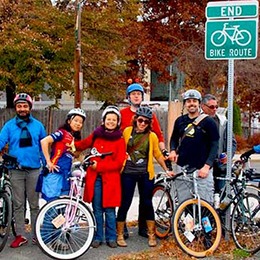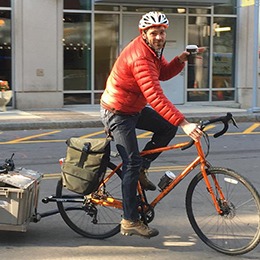EVERYDAY WINTER BIKING
Stay safe, warm, and bright
by Galen Mook
"Some of the most blissful, peaceful, and wondrous riding can be done in a snowy setting."
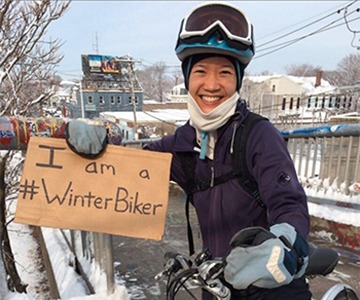
Biking... in the winter?!? Sounds daunting, especially with the New England winters we’ve come to know and fear. However, some of the most blissful, peaceful, and wondrous riding can be done in a snowy setting. All you need to have a great ride is to keep a few key points in mind to stay safe, warm, and bright.
I like to group my general biking tips under the umbrella terms: Comfort, Knowledge, Awareness. Most winter-specific concerns can be overcome by focusing on the main barriers: Cold, Darkness, Slippery Conditions.
Cold can be tackled by smart clothing, worn in layers, with a waterproof top. Darkness is combated by lights and reflectivity and more lights. And slipping is handled by changing technique to suit the conditions. Tip: Try a bit of mountain biking and you’ll be able to handle most conditions out there!
Adapting your technique
Technique is as important as equipment and clothing when it comes to staying comfortable out on slippery roads. Once the snow piles up and turns to icepack, there are subtle changes you’ll need to make to your riding so you stay “rubber side down.”
First of all, it’s hard to explain riding technique in a blog post. So I recommend taking the time to familiarize yourself with slipping and sliding in a safe environment such as a snowy parking lot or field – free of any obstacles or traffic. Call it "bike sledding." Next snowfall, go out with some friends, bundle up, and slide around. You’ll get a sense of what it means to have a shifting center of gravity and to lose traction on turns and when accelerating. For mountain bikers, this may be a familiar sensation, but most road bikers aren’t used to losing control while maintaining balance. Practice is always the best way to learn.
However, I can offer a few tips. You’ll likely want to lower your seat a centimeter or two so your feet are lower to the ground. This will make it easier to catch yourself when you slide in a turn, and hopefully keep you from sliding out. Be sure to take extra care when turning, and be sure to turn by steering – instead of leaning into the turn (which may be your habit if you are a road biker). Slow down on the turns and prepare your center of gravity in the event that you fish-tail and your rear wheel slides. But don’t worry, it’s OK to slip a bit, it’s almost inevitable in the snowy streets regardless of your mode of transportation – be it bike, car, or by foot.
Out in the streets, be sure to have plenty of space in case you do slip, and don’t pass too close to obstructions or cars. Ride in the travel lane, sometimes right in the middle of the lane, not squeezed to the right by the curb, and stay in-line with the rest of traffic. If the conditions are slick, you want to have as much space as possible to maneuver, so be comfortable riding in the center of the lane and over communicate to drivers using hand signals and eye-contact.
The best way to make everyone around you safer is to be predictable as possible, limiting any sudden movements, and signaling all turns and deviations from your straight line. You can practice by holding the handle bars straight and steady, especially when riding over slippery patches and ice where you must be careful not to turn or brake suddenly.
And when braking, be sure to give yourself space to slow down and stop. If your bike has rim brakes, you may need to apply the brakes and allow a full rotation of the wheel before the brake pads clean the rim and begin their grip. A good rule is you will need at least one full bike-length to clear the brakes before they achieve stopping power.
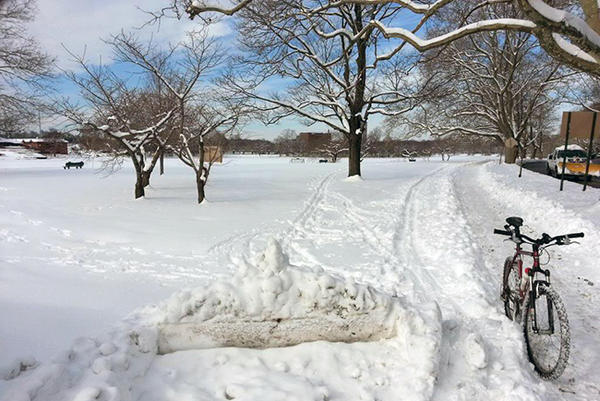
Biking in snow is fun!
Even though these tips may be daunting to consider, the truth is that riding in the wintertime is not just possible, it’s also FUN! The joy of riding is not a three-season activity. You can get out and explore in the cold and snow with equal freedom as in the warmer season. You’ll just need a bit of preparation, experience, and some wits to stay warm and safe out there.
Enjoy!
Photos: (Top) A rider shows the joy of riding in a Boston winter, credit @ABBikes #winterbiker campaign. (Bottom) A winter commuter bike taking a break along the Charles River pathway in Cambridge, credit Daniel Kamalic.
More Winter-Biking Tips
Learn how to prepare for winter biking and have more fun out there:
Winter Bikes at Landry's
Check out our selection of all-season bikes, including fat-tire mountain bikes — great for riding on snowy paths and trails!
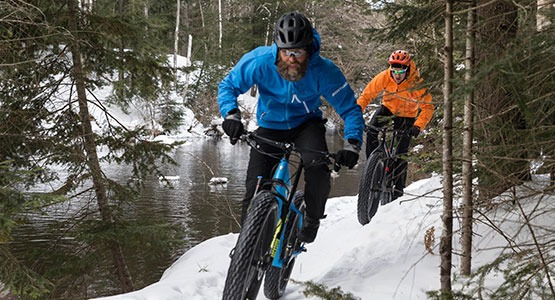
Everyday Biking Tips
by Galen Mook
Galen Mook formerly worked in Landry's marketing department, and he is now MassBike's executive director. Galen is a year-round bike commuter, experienced cycling instructor, and community advocate for better bicycling.

